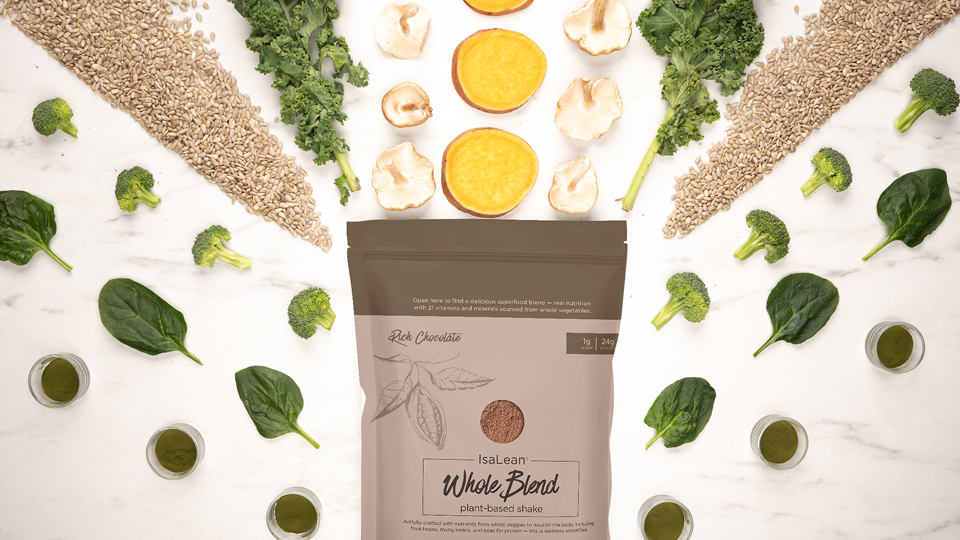There’s an increasing number of options when it comes to plant-based nutrition, but not all choices are the same.
Whether you follow a plant-based lifestyle or are just looking for variety, there are many benefits to adding more plant-based nutrition to your day. Plant-based shakes are a great option for everyone but offer an important alternative for those who avoid dairy products. Unfortunately, it can be hard to find a plant-based shake that offers high-quality ingredients and delivers the right nutrition to help you meet your goals.
Here are five features to look for when selecting a plant-based meal replacement shake.
1. High-Quality Protein With a Complete Amino Acid Profile
Protein plays many important roles in the body, such as providing structure to cells, controlling biochemical reactions, and aiding the immune system (1, 2). Unfortunately, many plant-based foods don’t provide all nine essential amino acids that are required for a complete source of protein.
Pulses such as beans and peas are some of the best plant-based protein sources, along with whole grains, nuts, and seeds. Combining several different plant-based proteins in the right proportions can create a nutritionally complete protein source with a full array of essential amino acids.
2. Good Source of Dietary Fiber
The average American consumes only half the recommended dietary fiber each day. Therefore, it’s important to choose a shake that provides a good source of fiber. A diet high in fiber is a great way to maintain digestive health and gut regularity. Adequate fiber is also important for managing blood sugar after meals, improving satiety, and decreasing caloric intake throughout the day (3). Together these effects can promote successful weight loss and maintenance.
3. Good Fats
Fat is a crucial aspect of a healthy diet and holds important value in quality meal replacements. However, not all fats are created equal. Studies show that diets providing monounsaturated and polyunsaturated fats that deliver a rich source of omega-3 fatty acids support cardiovascular health and may increase and sustain feelings of fullness (4, 5). Other fats like medium-chain triglycerides sourced from coconuts supply a quick source of energy and have been shown to support weight management (6).
4. Nutrients From Fruits and Vegetables
When choosing a balanced plant-based shake, make sure the ingredients include just that – plants! Many meal replacements focus solely on calories and protein, neglecting to incorporate the vitamins, minerals, and phytonutrients from fruits and vegetables that are important for many physiological functions. A diverse list of fruits and vegetables will provide you with an assortment of phytonutrients and vitamins and minerals beyond that of just one plant-sourced ingredient (7, 8).
5. A Taste You Enjoy
The main complaint with plant-based shakes is poor flavor and texture. That’s not the case for Plant-Based Whole Blend IsaLean® Shakes. Their deliciously smooth texture and flavors are sure to please your taste buds! In fact, this plant-based meal replacement shake isn’t solely for the enjoyment of vegetarians or those with food intolerances or sensitivities.
Plant-Based Whole Blend IsaLean Shakes are formulated with 24 grams of high-quality protein with an optimal amino acid profile from fava beans, mung beans, and peas. Each serving provides 8 grams of dietary fiber, healthy fats, and 21 vitamins and minerals sourced from organic whole vegetables. The best part is that it offers a great taste and good nutrition to just about any diet.
References
- Negro M, Giardina S, Marzani B, et al. Branched-chain amino acid supplementation does not enhance athletic performance but affects muscle recovery and the immune system. J Sports Med Phys Fitness 2008, 48:347-351.
- Cylwik D, Mogielnicki A, Buczko W. L-arginine and cardiovascular system. Pharmacol Rep. 2005;57:14–22.
- Slavin JL. Position of the American Dietetic Association: health implications of dietary fiber. J Am Diet Assoc 2008;108:1716-31.
- Rodriguez-Leyva D, Dupasquier CM, McCullough R, Pierce GN. The cardiovascular effects of flaxseed and its omega-3 fatty acid, alpha-linolenic acid. Can J Cardiol 2010;26:489-96.
- St-Onge MP, Jones PJ. Greater rise in fat oxidation with medium-chain triglyceride consumption relative to long-chain triglyceride is associated with lower initial body weight and greater loss of subcutaneous adipose tissue. Int J Obes Relat Metab Disord. 2003 Dec;27(12):1565-71.
- Abou-Samra R, Keersmaekers L, Brienza D, et al. Effect of different protein sources on satiation and short-term satiety when consumed as a starter. Nutr J. 2011 Dec 23;10:139.
- Chang KT, Lampe JW, Schwarz Y, et al. Low glycemic load experimental diet more satiating than high glycemic load diet. Nutr Cancer 2012;64:666-73.
- Chong, Perry Shi Hui. “Eat your rainbow: cultivating good food habits with storytelling for kids.” (2018).





